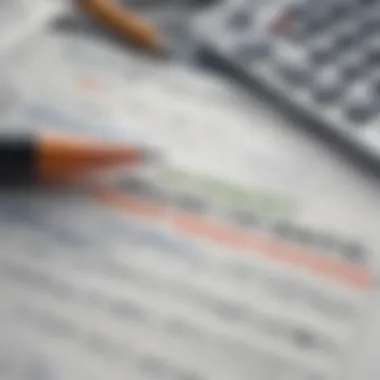Effective Strategies to Clear $10,000 Debt in 6 Months


Intro
Navigating the world of debt can often feel like trying to run through quicksand. You think you're making progress, only to find yourself sinking further. For many, a debt of $10,000 can become a looming shadow. However, it’s not the end of the line—it can be managed and erased with the right strategies and mindset.
This guide aims to break down the heavy armor of debt into manageable pieces, helping you to devise a solid plan to eliminate that debt within just six months. Understanding how to assess your financial situation, budget effectively, and maintain motivation along the way can turn this formidable task into a more achievable objective. We will also explore practical steps that anyone can apply, regardless of their current financial habits.
As we dive deeper, we will touch on key terms that are crucial in discussing financial subjects and outline actionable strategies that can steer your life in a more stable direction. With a careful approach that includes prioritizing expenses and disciplined behavior, achieving financial freedom is well within reach. Let's get started on this journey.
Understanding the Debt Landscape
Navigating the tangled maze of debt can feel like trying to find your way out of a forest with no clear paths. Understanding the debt landscape is essential, as it sets the stage for tackling a $10,000 debt within a six-month span. A clear comprehension of debt types, their implications and the importance of managing these financial obligations will not only equip you with the knowledge of where to start but also help you make informed decisions moving forward.
The Significance of Managing Debt
Effectively managing debt is not merely about paying off what you owe; it serves as a foundation for improved financial health. Without this management, debts can spiral, leading individuals into a deeper financial hole. Think of it as tending to a garden: if you neglect it, weeds take over and choke the life out of the plants. By focusing on debt management, one cultivates a healthier financial future. Balancing repayments with living expenses ensures you're not just scraping by, but rather building a more sustainable way of life. In essence, proactive debt management equates to financial empowerment.
Types of Debt
When discussing the types of debts, it’s crucial to distinguish between secured and unsecured debts as well as understanding revolving and installment debts. Each category influences how you approach repayment and management strategies.
Secured vs Unsecured Debt
Secured debts are backed by collateral, which provides a safety net for lenders. Examples include mortgages and car loans. This characteristic is a double-edged sword; while it may mean lower interest rates for borrowers, it also poses the risk of asset forfeiture if payments are missed. The unique feature here is the connection between the debt and a tangible asset. When it comes to debt elimination, understanding the stakes involved with secured debt is fundamental.
On the flip side, unsecured debt, such as credit card debt or medical bills, doesn't have collateral backing. This kind usually comes with higher interest rates, but missing payments won't result in the loss of a house or car. The benefit is flexibility, but with it, comes the disadvantage of potential long-term financial strain due to accumulating interest. Balancing both types plays a critical role in constructing an effective debt repayment strategy.
Revolving vs Installment Debt
Revolving debt, typically seen with credit cards, allows for a flexible balance that can change month-to-month. If managed correctly, it can be a useful tool that offers access to funds as needed. However, one must keep in mind that the interest can pile on if balances aren't paid off promptly. In terms of advantage, the flexibility can be a blessing, but it may lead to disadvantage if not monitored carefully.
In contrast, installment debt, such as a personal loan, involves fixed monthly payments over a set period. This predictability assists borrowers in budgeting, as they know precisely how much to allocate monthly toward the debt. However, the rigidity can also mean challenges in adjusting underspective financial conditions. Examining both types of debt gives clarity on how to navigate repayment, making it easier to incorporate into an overall strategy for elimination.
Recognizing the distinct types of debt is crucial when putting together your plan. This knowledge will shape your priorities and ultimately determine your success.
In summary, understanding this debt landscape reveals the multifaceted nature of financial obligations, which is paramount to conquering a sizable debt like $10,000. When the road seems daunting, remember that having a grip on these fundamental concepts can illuminate your way.
Assessing Your Current Financial Situation
To make progress in settling debt, one first need to have a firm understanding of their financial landscape. Assessing your current financial situation is like taking an X-ray of your finances—an essential step before making any treatment decisions. This evaluation sheds light on income levels, spending habits, and existing debts, and reveals areas that need addressing. Its significance cannot be overstated, as it enables a tailored approach to financial recovery.
Calculating Total Debt
The first step in evaluating your financial situation is to calculate the total debt. It’s not just about knowing you owe a certain amount; it's about identifying each obligation.
- List each debt: Start with a comprehensive list including credit cards, loans, and any other financial obligations. Note down the total amounts owed for each.
- Interest rates and terms: Keep an eye on the interest rates and repayment terms associated with each debt. Higher interest debts should be prioritized for quicker resolution.
- Create a debt inventory: A simple spreadsheet can be helpful to visualize your debts clearly. For instance, you might have:
- Credit Card 1: $3,000 at 18% APR
- Car Loan: $4,000 at 6% APR
- Personal Loan: $3,000 at 10% APR
By having all this information in one place, you can see the actual picture of your debt situation. This will serve as a touchstone as you develop your debt reduction plan.
Recording Monthly Income and Expenses
Next up is tallying your monthly income and expenses. Understanding both sides of the cash flow equation is essential. The goal is to see where your money is going and identify areas for savings.
- Income: Capture every source of income—salary, side jobs, dividends, etc. This could be something like:Summing these will give a clearer figure of the resources you can allocate toward debt repayment.
- Expenses: Track every expense, even the small ones. Identify fixed costs (like rent) versus variable costs (like dining out). It can be helpful to categorize them, possibly using something like:
- Main Job: $4,500
- Freelance Work: $500
- Passive Income: $200
- Fixed:
- Variable:
- Rent: $1,500
- Utilities: $250
- Groceries: $400
- Entertainment: $120
Regularly recording and reviewing these can create a concrete understanding of where your funds are tied up and ultimately, clear the fog around potential savings.
Identifying Financial Weaknesses
The last piece of the assessment puzzle is identifying financial weaknesses. This is the part where emotional intelligence meets cold hard facts. Recognizing patterns in spending or debt behavior is crucial for transforming your financial future.
- Assess habitual spending: Look for recurring purchases that, while not essential, add up over time. Maybe that morning coffee routine could be substituted with home-brewed coffee instead?
- Debt-related triggers: Understand the habits that lead to accumulating more debt. Are you prone to impulse buys when stressed?
- Seeking support: Sometimes, merely identifying these areas of weakness isn’t enough. Seeking guidance, whether from financial advisors or trusted peers, can bring fresh perspectives.
Reflection is key: By regularly scanning for weaknesses, you not only monitor your financial health but also develop adaptive strategies to stay on track.
In summary, assessing your financial situation involves three main factors: calculating total debt, recording monthly income and expenses, and identifying weaknesses. It’s this base knowledge that enables effective planning and, ultimately, successful debt elimination.
Creating a Budget to Achieve Debt Reduction
Creating a detailed budget is akin to drawing a treasure map to financial freedom, especially when trying to eliminate $10,000 in debt in just six months. A budget lays down the groundwork needed to approach debt reduction thoughtfully and strategically. It’s not just about tracking cents and dollars; it’s about developing a mindset that prioritizes financial stability and discipline. With a solid budget, you can identify where your money flows, allowing you to make informed decisions regarding your finances.
In this endeavor, it helps to grasp the basic components of your budget. You'll need to categorize your income and expenses, parsing through what can be adjusted or cut entirely. It is crucial to approach this process with an open mind. This is not merely a checklist; it’s a structured plan that can lead to tangible results. Let's delve deeper into the various elements of budgeting that drive debt reduction.


Establishing Fixed and Variable Expenses
Every budget revolves around two types of expenses: fixed and variable. Fixed expenses are the non-negotiables of your financial life; they stay consistent month to month and include things like rent or mortgage payments, insurance premiums, and loan payments. Variables, on the other hand, fluctuate. Think of groceries, entertainment, and utilities as areas where you might have some wiggle room.
To make headway in chipping away at your debt, it’s paramount to audit these expenses. Here are a few practical steps:
- List all your fixed expenses: Knowing what you must pay each month creates a solid foundation.
- Assess your variable expenses: Analyze spending patterns on things such as dining out or shopping. Can these be trimmed back?
- Identify which expenses can be reduced or eliminated: For instance, consider canceling subscriptions or cutting down on impulse buys.
Understanding these categories can help you redirect surplus funds toward your debt repayment, which ultimately helps in achieving your goal of erasing that $10,000.
Allocating Funds for Debt Repayment
Once you have your budget laid out, it’s time for the fun and critical part: figuring out how much you can allocate for debt repayment. This might require some old-fashioned penciling down of numbers, but it’s worth the effort. Treat debt repayment as an essential fixed expense.
Here are some guiding principles to consider:
- Prioritize high-interest debts: Allocate funds first to debts commanding the steepest interest rates. Every dollar saved in future interest is worth its weight in gold.
- Establish a payment schedule: Set a timeline for repayments. Weekly or bi-weekly payment strategies can sometimes help by breaking down larger sums into more manageable pieces.
- Track your allocation: Regularly monitor whether your allocations align with your goals. If you find any surplus due to savings or other adjustments, direct that into debt repayment without hesitation.
This approach not only aids in staying on top of repayments but also reinforces discipline by creating a habitual flow of funds directed solely toward eliminating debt.
Setting Realistic Financial Goals
Lastly, let’s not forget the backbone of maintaining your motivation through this journey: setting realistic financial goals. Thinking strategically about your financial aspirations is vital. Aim for milestones that are specific, measurable, achievable, relevant, and time-bound—often referred to as SMART goals.
Some examples include:
- Paying off $1,500 within the first month: This gives you a tangible target to work towards, breaking that $10,000 into smaller chunks.
- Tracking progress bi-weekly: Set intervals to assess how far you’ve come, adjusting your strategy as needed.
- Celebrating minor victories: Treat yourself (within budget) when you reach certain amounts paid off; it reinforces positive behavior.
You might even consider developing a vision board that outlines your goals. Keeping your aspirations front and center helps maintain momentum and encourages a responsible spending mentality.
Remember, every little bit counts. Small consistent efforts add up over time.
Through careful budgeting and disciplined financial management, achieving debt freedom is well within grasp. Implementing these methods sets you on a path to dismantling that $10,000 debt in a structured and meaningful manner.
Strategic Debt Repayment Methods
Navigating out of a financial quagmire like a $10,000 debt calls for a sharp strategy. Strategic debt repayment methods provide structured plans that empower individuals to take control, create a manageable path, and decide precisely how to allocate their finances. Choosing the right strategy can make all the difference between drowning in interest payments and breathing freely at the end of six months. These methods often hinge on prioritizing certain debts, optimizing repayment schedules, and utilizing financial resources effectively. Let's take a closer look at two main strategies: the Snowball and Avalanche methods, as well as the option of consolidating debt.
Snowball vs Avalanche Method
When it comes to repaying debts, the Snowball and Avalanche methods offer contrasting approaches that cater to different psychological and financial needs.
The Snowball Method focuses on paying off the smallest debts first, regardless of interest rates. By knocking out smaller debts quickly, the individual gains a sense of achievement. That feeling can be like a shot of adrenaline, motivating you to tackle the remaining debts. However, while this approach can be great for keeping morale high, it might not always prove to be financially effective, especially if larger debts carry much higher interest rates.
On the other hand, the Avalanche Method emphasizes tackling high-interest debts first. This method is often more cost-efficient because it minimizes the amount spent on interest over time. Suppose you have a $5,000 credit card debt at a 20% interest rate and a $3,000 personal loan at 5%. The Avalanche suggests you focus on that credit card first. This method might not provide the same quick wins as Snowball but it does yield greater long-term financial benefits.
Ultimately, the best method depends on your personality and what will keep you motivated.
"Choose the strategy that not only fits your financial situation but also aligns with your psychological comfort."
Consolidating Debt
Consolidating debt is another practical approach for individuals looking to simplify their repayment process. This tactic involves merging multiple debts into a single loan with a potentially lower interest rate. Banks and credit unions often offer personal loans designed specifically for this purpose.
Consider the following benefits of consolidating debt:
- Single Payment: Rather than juggling various payments on multiple debts, you only need to keep track of one monthly payment, making management easier.
- Lower Interest Rates: If you opt for a consolidation plan that offers a lower interest rate than your current debts, you could save a good chunk in interest payments.
- Improved Cash Flow: With potentially lower monthly payments, you may find your budget more manageable, allowing for extra savings or more aggressive debt repayment.
However, it’s essential to approach consolidation with caution. You must scrutinize terms and fees attached to the new loan, ensuring you aren’t merely shifting the deck chairs on the Titanic. Sometimes the allure of a lower monthly payment comes with a longer repayment period, which can lead you to pay more in interest over time.
In summary, strategic debt repayment methods are vital steps in the journey out of debt. Whether you choose the motivational boost of the Snowball method, the long-term savings of the Avalanche method, or the simplicity of debt consolidation, each has its merits. Prioritizing your approach can pave the way towards financial freedom.
Finding Additional Income Sources
When it comes to eliminating a hefty debt like $10,000 in just six months, one crucial area that cannot be overlooked is the generation of additional income. Finding ways to augment your current earnings not only provides more funds for debt repayment but also offers a cushion for financial emergencies. This proactive approach can be the difference between drowning in debt and attaining financial freedom.
Increasing your income gives one greater financial flexibility. With the right strategies, almost anyone can find ways to make extra cash, whether through temporary gigs or perhaps turning a hobby into a revenue stream. Not only does it help chip away at the debt faster, but it also instills a sense of accomplishment and boosts morale, pushing individuals to stick to their goals with renewed vigor.
Exploring Side Hustles
Side hustles have become all the rage these days, and for good reason. They allow individuals to earn money outside their regular jobs, creating potential additional cash flow. The best side hustle is one that matches your skills, passion, or availability.
Here are some popular side hustle ideas:
- Freelancing: Websites like Upwork or Fiverr allow professionals to offer their services, be it writing, designing, or programming.
- Tutoring: If you have expertise in a subject, offering tutoring services can be rewarding both monetarily and personally.
- Ridesharing: Companies such as Uber and Lyft enable individuals to make money by driving in their spare time.
- Delivery Services: Partnering with delivery apps like DoorDash or Postmates can make use of time typically spent idle.
However, there are some considerations to keep in mind. Evaluate your schedule carefully. Dedicating too much time to a side hustle can lead to burnout, which ultimately affects the primary job and overall quality of life. Balance is crucial.
Selling Unused Assets
Many people have items gathering dust in their homes, and those could actually be turned into cash. Selling unused assets can quickly raise funds that can go directly towards paying off debt. It's a sensible and often cathartic way to declutter while simultaneously reclaiming some financial power.


Look around your space and think about:
- Electronics: Gadgets like old smartphones or laptops can sell for decent prices on platforms like eBay or Craigslist.
- Clothing: Clothes that haven’t seen the light of day can be sold to stores specializing in secondhand items or through online marketplaces like Poshmark.
- Furniture: Unused furniture takes up space and can often be sold in local community groups on Facebook or via apps like OfferUp.
- Collectibles: Whether stamps, coins, or action figures, there might be buyers interested in something that has little value to you but a significant value to another.
"You'd be surprised how much cash you can easily free up just by turning your unused stuff into funds."
Before parting ways with items, ensure to do some research on their value to avoid underselling anything. This approach not only helps relieve financial strain but can also inspire individuals to adopt a more minimalist lifestyle.
Ultimately, finding additional income sources is not just about the money—it can also bring fresh perspectives into your life and open doors to new opportunities.
Cutting Expenses Wisely
When it comes to eliminating $10,000 debt within six months, cutting expenses wisely stands as a cornerstone strategy. It may sound straightforward, but pruning unnecessary costs can yield significant relief in your financial obligations. Not only does it help free up money for repayment, but it also cultivates healthy spending habits. While the end goal is to achieve debt freedom, the journey is equally about transforming your relationship with money. Understanding this concept is crucial and lays the groundwork for sustainable financial practices going forward.
Identifying Non-Essential Expenses
The first step to cutting expenses is figuring out where your hard-earned money goes. Often, we’re unaware of those little expenses that add up over time – I call them the ‘money leaks’. Think about your daily coffee runs, monthly magazine subscriptions, or even that gym membership you haven't used in ages. Assessing your spending habits through a meticulous review of bank statements can illuminate these non-essential expenses.
- Start by listing monthly costs in two columns: essential and non-essential.
- Take a hard look at discretionary spending. This includes entertainment, dining out, and shopping sprees. It’s easy to justify small purchases, but collectively they can create a hefty burden on your budget.
Being honest with yourself about what you truly need versus what you want is paramount. For instance, swapping out lunch at a fancy restaurant for home-prepared meals can spark significant savings without skimping on satisfaction. Every penny you save can be reallocated towards your debt, ultimately accelerating your journey to financial freedom.
Negotiating Bills and Services
Once you’ve identified potential savings, it’s time to tackle the bills that often feel set in stone. Many people don’t realize that it’s possible to negotiate rates on things like cable, internet, and even insurance premiums. It might feel daunting at first, but it’s worth the effort. Here are some practical steps:
- Research Competitors: Before making that call, look into what other providers are offering. This gives you leverage in discussions.
- Contact Customer Service: Politely explain your situation and express interest in lowering your bill. Many companies are willing to offer discounts to retain loyal customers.
- Inquire About Discounts: Don’t hesitate to ask about any seasonal promotions or loyalty discounts you might qualify for.
Negotiation can save you anywhere from $20 to $100 or more each month, and while that may not seem like a lot, it quickly adds up. This strategy empowers you to take control of your expenses while fostering a mindset of proactive financial management.
Adopting a Minimalist Lifestyle
Another powerful way to cut expenses is by embracing a minimalist lifestyle. This approach isn’t just about decluttering your living space; it's a transformative mindset that prioritizes quality over quantity. By focusing on what truly adds value to your life, you can drastically reduce your spending. Here’s how you can get started:
- Evaluate What You Own: Go through your belongings and consider selling or donating items that no longer serve a purpose.
- Rethink Purchases: Before acquiring anything new, ask yourself if it's something you truly need. Implement a waiting period before making purchases to curb impulse buying.
- Simplify Your Choices: Streamline your options, whether it’s meal planning with fewer ingredients or selecting a smaller wardrobe. Simplifying removes the overwhelming noise of choice, saving both time and money.
"By understanding that happiness does not stem from clutter, one can find freedom in simplicity."
These steps can lead to increased savings while providing a refreshing sense of clarity in both your living space and financial landscape. As you become accustomed to evaluating needs versus wants, the journey toward reducing your debt becomes that much clearer.
Maintaining Discipline and Motivation
Maintaining discipline and motivation is crucial for anyone tackling the challenge of eliminating a $10,000 debt within a tight timeframe of six months. It’s not just about having a solid plan or a strict budget; it's about cultivating a mindset that fosters persistence and resilience against setbacks. This section will dissect the specific elements that keep individuals engaged and on track, highlighting the tangible benefits of accountability and the considerations one should bear in mind throughout this journey.
Setting Short-Term Milestones
Establishing short-term milestones is like laying stepping stones on a winding path to debt freedom. You can break the overall goal of eliminating that hefty debt into bite-sized, attainable targets. For instance, if you need to tackle that $10,000 in six months, consider dividing it into monthly targets of approximately $1,666.67, with a focus on repaying even more in the first months, if possible.
Benefits of setting these milestones include
- Boosting confidence: Each milestone achieved provides a sense of accomplishment that fuels your motivation.
- Providing clarity: Clear goals help you understand what’s expected, reducing feelings of being overwhelmed.
- Facilitating adjustments: Short milestones allow you to tweak your approach based on what’s working or what isn’t, keeping your strategy adaptable.
Consider creating a visual tracker, such as a chart or a whiteboard where you can mark your progress. This not only serves as a visual reminder of your goals but also creates a sense of accountability.
Tracking Progress Regularly
Regularly tracking your progress can make all the difference. It helps in maintaining focus and motivates you to keep pushing forward. It might sound tedious, but it’s akin to checking your watch during a long race; it reminds you how far you’ve come and how far you still have to go.
To track your progress effectively, consider the following measures:
- Maintain a ledger: Record every payment made towards your debt. This not only provides a tangible record but also cultivates a sense of ownership over your financial journey.
- Use budgeting apps: Applications like Mint or YNAB can help streamline this process. They facilitate easy monitoring of your income and expenses, aiding in the visualization of your debt repayment journey.
- Monthly self-review: At the end of each month, take a moment to review your accomplishments. Celebrate victories, however small, and assess what areas might require more attention.
"Monitoring your progress isn’t just about numbers; it’s about understanding your relationship with money and recognizing the changes you’re making."
Tracking progress can highlight both the challenges and victories along the way, offering insights into spending habits or areas where discipline may wane. The consistency of checking in with your progress ensures you’re not just running on autopilot, but actively engaged in your financial freedom.
In essence, the elements of discipline and motivation are interwoven threads in the fabric of successful debt elimination. Regularly setting milestones and tracking advancements creates a sustainable rhythm, reinforcing the journey toward financial freedom.
Utilizing Financial Tools and Resources
Managing debt doesn't just require personal fortitude and diligent budgeting; it also involves harnessing the right financial tools and resources. In today's digital age, plenty of resources can make the journey toward debt freedom smoother. By leveraging these tools effectively, individuals can take charge of their financial lives and significantly streamline their repayment strategies.
Budgeting Apps and Software
The era of pencil and paper budgets is behind us. Nowadays, budgeting apps and software stand as invaluable allies in the fight against debt. These digital tools provide a framework to visualize income, expenses, and debts, permitting a granular understanding of one’s financial landscape.
- Real-Time Tracking
Budgeting apps like Mint and YNAB (You Need a Budget) offer real-time tracking of expenses. This feature allows users to see where their money is going, helping them make informed decisions promptly. - Goal Setting
Most budgeting tools allow users to set financial goals. For instance, knowing how much to allocate toward debt repayment versus discretionary spending can fortify one’s commitment. This goal-oriented approach encourages consistent discipline. - Automated Alerts
Another perk of using apps is the automated alerts. Whether it’s reminding individuals of upcoming bills or notifying them when they are nearing budget limits, these alerts can help prevent overspending. - Data Analytics
Many applications also provide analytics on spending habits, identifying areas where one might cut back. Understanding spending patterns can pave the way for smarter financial choices moving forward.
All these features combine to create an efficient system for handling debt, making apps a crucial player in debt management.
Financial Advisory Services


It’s not uncommon for individuals to feel overwhelmed or unsure about the best steps to take regarding debt. Financial advisory services can be a boon in such scenarios. Consulting with a professional can shed light on personalized strategies tailor-made for your unique situation.
"Financial advice is not one-size-fits-all; it’s about fitting the right solution to the right person."
- Expert Guidance
Financial advisors can provide insights that go beyond surface-level advice. They can analyze your overall financial profile to create a comprehensive plan that considers both current debts and future financial goals. - Investment Strategies
Some financial advisors go beyond debt repayment, offering investment strategies that can position you better for the future, potentially multiplying your wealth down the line. This can be a game-changer, especially after achieving debt freedom. - Accountability
Regular meetings with a financial advisor create a sense of accountability. Knowing someone else is tracking your progress can bolster motivation and discipline, essential components in the journey of paying off significant debts. - Practical Resources
Lastly, advisory services often provide access to additional resources that may not be readily available to individuals. Whether it’s specialized debt consolidation options or educational materials, these resources can enhance your financial literacy.
The Long-Term Benefits of Debt Freedom
Achieving debt freedom is not simply a fleeting moment to celebrate; it paves the way for a whole new financial life. Many who have tackled their debt will tell you that the sense of relief is palpable, but the benefits extend far beyond just feeling unburdened. When one takes the important steps to eliminate $10,000 in debt, they unlock a variety of long-term advantages that can significantly alter their financial landscape.
"Debt looks like a chain, but being free feels like flying."
One of the most crucial benefits lies in the improvement of one’s credit score. A stronger credit score is something that can open doors that were previously shut tight. Whether it’s qualifying for a low-interest mortgage or being approved for better credit terms, a good credit score enhances your financial reputation. Moreover, better credit often leads to lower interest rates on any future loans. This can translate to large savings over time, which is quite significant when you sum it all up.
Improved Credit Score
A key component of financial health, credit scores reflect how reliable you are to lenders. When you begin chipping away at your debt, you will likely see a gradual increase in your score. This is because paying off debts reduces your credit utilization ratio, which is how much credit you’re using relative to your total available credit.
Here are some specifics on how reducing debt positively impacts your credit score:
- Lower Credit Utilization: Ideally, your credit utilization should remain below 30%. Paying down debt increases your available credit, thus improving this ratio.
- Payment History: On-time payments show lenders that you are responsible. This will gradually boost your score as you clear off your debts.
- Debt-to-Income Ratio: Reducing debt decreases the portion of your income going toward existing obligations, making you more appealing to lenders when you seek new credit.
Following through with a debt reduction plan means that you are not only surviving but thriving, too.
Greater Financial Freedom and Flexibility
Once you have cleared that dreaded $10,000 debt, financial freedom becomes more than just a mirage. It creates a cushion allowing you to make choices without the weight of financial stress. You gain the ability to invest in opportunities that arise, save for future goals, or even splurge on a well-deserved vacation without guilt. This shift isn't just about numbers on a bank statement; it's about reshapening your lifestyle.
Some of the flexible options available once debts are eliminated include:
- Building Savings: You can finally set money aside for emergencies, head off unexpected costs, or even plan for retirement through investments in IRAs or 401(k)s.
- Pursuing Opportunities: Whether it's changing jobs or starting a side business, financial freedom gives you the confidence to take risks.
- Improved Mental Health: The psychological relief that comes with being debt-free is invaluable. It can lead to lower stress levels and enhance overall well-being.
Achieving debt freedom is a journey worth undertaking, not just for today but for a brighter financial future. As you reflect on various strategies lined out for eliminating debt, keep in mind the long-lasting benefits that will shape your financial life for years to come.
Common Pitfalls to Avoid
Managing debt isn’t just about creating budgets and sticking to them; it’s also about navigating the treacherous waters of common pitfalls that could derail even the best-laid plans. Understanding these pitfalls can help you stay on course and achieve your goal of eliminating $10,000 in just six months. Awareness of what can go wrong is essential, as it allows you to preemptively address potential issues. By keeping these common pitfalls in mind, you can boost your chances of maintaining your financial discipline and ultimately achieve the freedom you seek.
Ignoring Small Debts
One of the most significant mistakes people make in debt management is overlooking small debts. Often, individuals focus heavily on larger debts while considering minor ones as insignificant. However, small debts can add up and become a considerable challenge. This issue isn't purely about the amounts involved; it's also about the psychological burden these debts impose. A cluttered financial landscape can distract you from your goals.
Ignoring small debts leads to higher stress levels and can create a situation where, after clearing bigger debts, these smaller obligations unexpectedly linger and make you feel like you haven’t really achieved that debt-free status. In your journey toward eliminating $10,000, you must remember:
- Every dollar counts: Regardless of size, every dollar that’s paid off contributes to your overall goal.
- Debt snowball effect: Paying off small debts first can generate momentum. You’ll feel accomplished, which helps combat the feeling of being overwhelmed.
By not addressing minor debts, you not only risk financial stagnation but also jeopardize your motivation. Taking charge of all obligations, no matter their size, is integral to a successful debt-reduction strategy.
Falling Back into Bad Habits
After making progress in debt elimination, the temptation to fall back into previous habits can be significant. Often, individuals experience a sense of freedom as debt decreases, leading them to spend money more freely than before. This can quickly create a slippery slope.
Such habits may include:
- Impulse purchases: Buying on a whim can slowly begin to chip away at your financial discipline.
- Neglecting budgets: As debts diminish, it’s easy to abandon the strict budgeting that initially helped in repayment.
- Disregarding savings: In the thrill of reduced obligations, you may forget the importance of saving for emergencies, which could lead to accruing debt again.
To prevent falling back into bad habits, consider these strategies:
- Automate Savings: Set aside money for savings right when you receive your paycheck.
- Regular Financial Check-Ins: Periodically reassess your budget and progress to stay on track.
- Stay Accountable: Sharing goals with a friend or family member can reinforce your commitment.
"It's not just about eliminating debt; it's about changing the mindset that got you there in the first place."
The path to financial freedom is a continuous journey, not a destination. By avoiding the pitfalls of ignoring smaller debts and slipping back into previous habits, you position yourself for lasting success.
This mindful approach lays the groundwork for sustainable debt management, enabling you to maintain a clearer financial path well beyond your six-month goal.
Concluding Thoughts on Debt Management
Debt management is a journey, not just a destination. It's about navigating the often murky waters of personal finance with clarity and intention. For those grappling with significant debt like $10,000, the end goal is not merely to clear the balance; it's about understanding the intricacies of one’s financial landscape and emerging stronger and wiser. The strategies outlined earlier provide a roadmap, but the true essence lies in the mindset shift that occurs during this process.
The Importance of Financial Awareness
Being aware of one's financial state is paramount. Without this awareness, it is all too easy to get lost in the weeds. Consider this: a person who tracks their spending is likely to notice patterns—perhaps they spend an excessive amount on takeout or subscriptions that no longer serve them. Recognizing these habits is the first step toward making informed choices. The more you know about your financial situation, the more control you have over it. Here are several key points to keep in mind:
- Comprehensive Understanding: It’s crucial to have a clear picture of all debts, interest rates, and monthly obligations.
- Regular Reviews: Check your finances regularly—this helps in spotting trends and adjusting plans as needed.
- Education: Invest time in learning about personal finance; understanding concepts like interest and amortization can be game-changers.
Financial awareness empowers individuals to take actionable steps rather than remaining at the mercy of their financial circumstances. A little knowledge can go a long way in achieving financial independence.
Encouraging Sustainable Financial Practices
Sustainable financial practices go hand in hand with effective debt management. These practices don’t just help eliminate debt, they also set the foundation for a future devoid of that albatross hanging over your finances. Consider these sustainable strategies:
- Building an Emergency Fund: Even while paying down debt, having a small emergency fund can prevent setbacks from unexpected expenses.
- Living Within Your Means: Adopting a lifestyle that aligns with your financial reality keeps debt at bay and shields you from future financial pitfalls.
- Acknowledging Small Victories: Celebrating small milestones fosters motivation and reinforces the habit of good financial practices.
Establishing a routine that prioritizes budgeting, saving, and conscious spending isn’t merely about surviving; it’s about thriving in an often unpredictable financial world. Sustaining these practices can make it easier to resist the temptation of accruing new debt, paving the way for long-term financial stability.
"The road to financial freedom is dotted with the checkpoint of discipline and awareness."
In sum, wrapping up on debt management emphasizes not just the strategies for eliminating that pesky $10,000, but the sweeping changes in mindset and practice it encourages. It's about digging deep into personal financial habits and restructuring them for better long-term outcomes.



